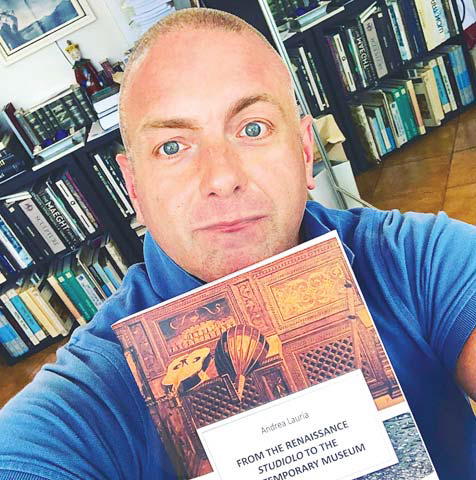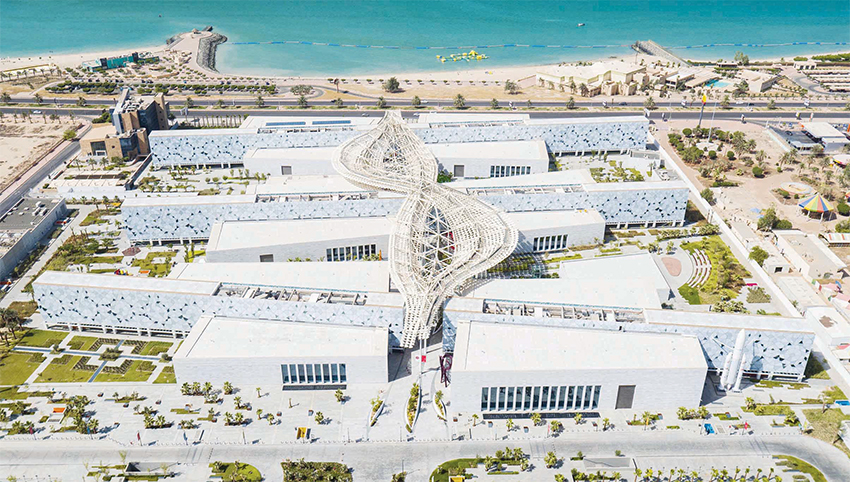16/02/2023
16/02/2023
HYPER-MUSEUMS BRIDGE CULTURES

Prof. Andrea Lauria (right) is an Italian museologist graduated from Rome’s Accademy of fine arts. He also holds a History of Art degree from University di Roma Tre in Rome. Andrea Lauria lectures a Masters course in museology at Rome’s Universities Tor Vergata and American Temple University (Rome Campus). In 2020 he has become a published author of the book: From the Renaissance studiolo to the contemporary museum which is also his course manual. Lauria’s field of research is the phenomenon of hyper-museums with special attention to the Arabian countries in comparison with the Western world
It is an extraordinary opportunity to bridge the gap between Western and Middle Eastern societies, countries and cities through the hyper museums which very much differ from each other in various aspects, but the features of hyper-museums tell the tale of two cultures which interconnects the West with the Middle East. If the Western and Middle Eastern societies, countries, cities very much differ from each other in various aspects, the features of hyper-museums bind together the two cultures.

In my first article I will take the reader on a kaleidoscopic journey of hyper-museums in the 21st century and how this phenomenon birthed in the United States and the European Union before subsequently drifting towards the Middle East. In the articles that will follow, I will analyze the various aspects of hyper-museums in the Middle East and the world beyond.
The hyper-museum which is about the spectacular and imposing volume, formal and aesthetic choices that resemble a sculpture more than a building, which in itself is an amazing edifice to the ‘eye of the beholder’ is a global museographic and museologiacal phenomenon which saw its birth in the 20th Century until it fully evolved into the 21st Century.

Simply put the hyper-museum phenomenon is a competition between the content and the container basically a strong prevarication of architecture of the first time collection. The priority is to turn the museum building into something spectacular to bring effectiveness to the works of art -- that are independent of its exhibitive function and that have been preserved and displayed. The hyper-museum cannot be considered as something simply built to collect works of art and is unlike traditional museums because of their expressive power which is more often than not is so strong. Its expressive power is so strong that the collection’s principal work of art to be considered is the building itself. In the urban context, the hyper-museum is a towering edifice influencing not only the neighborhood where it stands located but the entire city.
The great success of the hyper-museum is due to the creative potential that makes it an excellent means of communication. During the 20th and 21st centuries, hyper-museums have become meeting points for an increasingly large, diverse and demanding public who desire to have not only bigger exhibition spaces but also large areas for entertainment.
The great success of the hyper-museum is due to the creative potential that makes it an excellent means of communication. In a global society, in which the architects of hypermuseums are looked upon as international archi-stars, are called upon to build museums and works of art because their fame is a vital essence for the success of hyper museums as seen through the eyes of the media.

All hyper museums are open to the public, accessible and inclusive, foster diversity and sustainability and have the same features. They are spectacular, scenographic, and vast
and in some way interconnect with the life of the people welcoming and entertaining everyone in the best possible manner. The building itself is a work of art that is independent of its exhibitive function with a formal and aesthetic identity with which the archi-star declares his or her vision.
The phenomenon of the hyper-museums started with Solomon Robert Guggenheim Museum in New York, the final great project of American architect Frank Lloyd Wright, one of the most infl uential architects of the 20th century.
Lloyd Wright was commissioned by the American magnate Solomon R. Guggenheim who wanted to display his art collection which included masterpieces by Vassily Kandinsky, Piet Mondrian, Marc Chagall, Robert Delau-nay, Fernand Léger, Amedeo Modigliani and Pablo Picasso.
The innovations introduced by the American museum were astounding, especially when considering that the Guggenheim was established in 1959 but the projects for its construction started in 1943, when the classical museum model was still widespread in the USA as can be seen at the National Gallery of Art in Washington which opened in 1937.
S.R. Guggenheim Museum in New York is one of the most important architectural works of the 20th century one that is still recognised as one of the masterpieces of contemporary architecture to this day, it is also the museum that revolutionised museum architecture in the 20th century.
S.R. Guggenheim Museum in New York, which is the prototype of the hyper-museum in addition to being an a strong urban landmark influencing the entire neighborhood. Over subsequent decades the New York S.R. Guggenheim Museum went on to become one of the central models in museum architectural design.
A museum that can be considered the perfect example of the hypermuseum is The Guggenheim Museum Bilbao commissioned to Frank O. Gehry is one of the most influential names of the Deconstructivism movement (a Postmodern architectural movement) and one of the most famous architects at international level.
From an aesthetic and formal point of view, the museum is surprising due to its structure which is extreme, unusual and rash. The Guggenheim Museum Bilbao is a work without precedent, due to its museography and museology but also its architecture and city planning. The museum has a strong impact on the area and the suburb, but it manages to fit well with the surrounding spaces and it was fundamental in the requalification of the city and the surrounding area. It became not only the greatest landmark of the city but also the new symbol of the city and its new identity, which helped Bilbao to escape oblivion, giving it notoriety and international fame instead.
The Guggenheim Museum Bilbao completes the 20th century. It became a bridge between the museums architecture of the 20th century and the future museums architecture of the 21st, which will consider the Guggenheim Museum Bilbao a key, indispensable reference. Two excellent and interesting 21st century European hyper-museums that can be cited are MAXXI and Fondation d’entreprise Louis- Vuitton. MAXXI opened in 2010 is located in Rome and was designed by Architect Zaha Hadid (Baghdad, 1950 - Miami, 2016). Hadid was an Iraqi–British architect and designer who was one of the leading exponents of Deconstructivism. She won many awards: the Pritzker Prize in 2004 (the first woman to receive it) and the Stirling Prize in 2010 (for the MAXXI project) and in 2011.
The Fondation d’entreprise Louis-Vuitton museum opened in 2014 and it was designed by Frank O. Gehry who had designed the Guggenheim Museum Bilbao was chosen. In recent years many Arab countries have understood the media power of this phenomenon and have decided to build hyper-museums. These are all buildings with ultramodern shapes and are above all built on a huge scale. With the creation of these large museum centers, which triggered an inevitable competition between them, the Middle Eastern countries involved in this process aim to compete and oppose the prestigious museum realities of the West.
These museums include the Sheikh Abdullah Al Salem Cultural Centre (ASCC) in Kuwait City, Kuwait, designed by the SSH, one of the most important design firms in the Middle East. Inaugurated in 2018, the center is the definitive Kuwaiti museum and is the largest museum and exhibition center in Kuwait, as well as one of the largest in the world thanks to its surface area of 22,000 m2.
The other hyper-museums in the Arab peninsula that we must mention are the wonderful Louvre Abu Dhabi (Louvre A.D.), also known as the Museum of Civilisations, inaugurated in November 2017 on Abu Dhabi’s Saadiyat Island and National Museum of Qatar (NMoQ) opened in 2019 and located in Doha in Qatar. Both museums are the work of great international French archi-star Jean Nouvel (Fumel, 1945), winner of many important awards such as the Pritzker Prize in 2008.
In addition to the Gulf countries, the phenomenon of hyper-museums is evident in Egypt which, despite not having the same economic resources as the UAE, Kuwait, or Qatar, has nevertheless understood the media power of hyper-museums and how through the hyper-museums they can change the image of their country. The two Egyptian hyper-museums are the National Museum of Egyptian Civilization (NMEC) inaugurated in 2021 and the Grand Egyptian Museum (GEM) that will be established probably 1n 2023. Both hyper-museums are located in Cairo. Heneghan Peng Architects, Grand Egyptian Museum (GEM), (2023 ?), Il Cairo. Today I have explained to you the birth and the evolution of the hyper-museum by comparing the Western world with the Middle Eastern one. In the next article we will talk about the amazing Louvre Abu Dhabi, United Arab Emirates designed by Jean Nouvel. By Andrea Lauria


